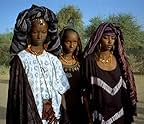Wodaabe - Die Hirten der Sonne. Nomaden am Südrand der Sahara
- Fernsehfilm
- 1989
- 43 Min.
Füge eine Handlung in deiner Sprache hinzuHerzog's documentary of the Wodaabe people of the Sahara/Sahel region. Particular attention is given to the tribe's spectacular courtship rituals and 'beauty pageants', where eligible young ... Alles lesenHerzog's documentary of the Wodaabe people of the Sahara/Sahel region. Particular attention is given to the tribe's spectacular courtship rituals and 'beauty pageants', where eligible young men strive to outshine each other and attract mates by means of lavish makeup, posturing a... Alles lesenHerzog's documentary of the Wodaabe people of the Sahara/Sahel region. Particular attention is given to the tribe's spectacular courtship rituals and 'beauty pageants', where eligible young men strive to outshine each other and attract mates by means of lavish makeup, posturing and facial movements.
- Regie
- Drehbuch
- Hauptbesetzung
- Narrator
- (Synchronisation)
Empfohlene Bewertungen
Do they use mirrors to apply their makeup. None are seen, but some of the young men are holding their hands as if they have a mirror, but this is not confirmed by the camera.
Amazingly, there are no tourists at the festival. Only the German camera crew. We are not shown how the Wodaabe relate to being filmed by these foreigners.
As this film was made for French television, and the opening titles and commentary and the closing credits are in French, should not the French title be the prime one?
Though surely only a small taste, the movie serves up a vibrant, flavorful portrait of the Wodaabe. We see their pastoral lifestyle, and the difficulty in maintaining it in light of shifting climates, government involvement, and the impact of the latter on the former. We see their marvelous, eye-catching clothes and makeup, especially those relative to the social rituals that lie at the heart of Herzog's picture. And for as outwardly different and subjectively strange as Wodaabe culture appears - just as with the people showcased in any of the filmmaker's productions, what becomes evident with the presentation is that all of humanity shares much in common with one another across time and space than it does not. Parallels can be drawn between any two societies, no matter how far-flung. And especially with that in mind, no matter how you look at it, 'Herdsmen of the sun' is wonderfully interesting, and altogether fascinating. Clocking in at a trim 50 minutes, this is worth more than the time it takes to watch.
They are traditionally nomadic cattle-herders and traders in the Sahel, with migrations stretching from southern Niger, through northern Nigeria, northeastern Cameroon, southwestern Chad, and the western region of the Central African Republic. Today (2016) they are estimated to number around 100,000.
I have to thank Herzog for this document. I am not sure if I had heard of the Wodaabe before, but they are a fascinating people, mixing African traditions with Islamic culture, and certainly a variety of their own practices. The makeup and other modifications almost make them look fake, like china dolls or some such thing. Why they consider themselves such beautiful people is easy to see.
In comparison, this documentary by Werner Herzog is more about the overall lifestyle of the people. It subtitles their language and individuals are questioned on screen by the translator. The soundtrack uses opera music in some places.
In my opinion, neither film is great. "Herdsmen of the Sun" is probably more interesting and better filmed and edited than "Deep Hearts", while the latter is probably more authentic.
Wusstest du schon
- VerbindungenFeatured in Was ich bin sind meine Filme - Teil 2... nach 30 Jahren (2010)
Top-Auswahl
Details
- Erscheinungsdatum
- Herkunftsländer
- Sprachen
- Auch bekannt als
- Herdsmen of the Sun
- Drehorte
- Niamey, Niger(bridge at the end)
- Produktionsfirmen
- Weitere beteiligte Unternehmen bei IMDbPro anzeigen
Zu dieser Seite beitragen
















